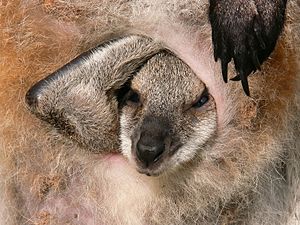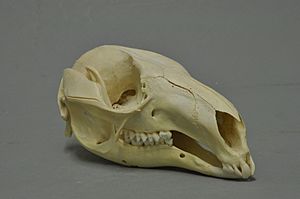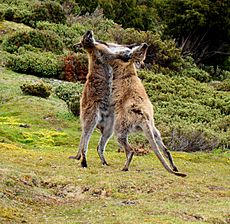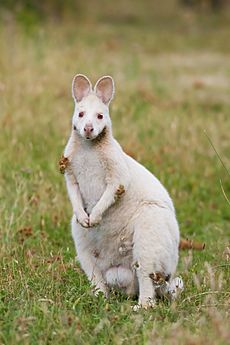Red-necked wallaby facts for kids
Quick facts for kids Red-necked wallaby |
|
|---|---|
 |
|
| Conservation status | |
| Scientific classification | |
| Kingdom: | |
| Phylum: | |
| Class: | |
| Infraclass: | |
| Order: | |
| Family: | |
| Genus: | |
| Binomial name | |
| Macropus rufogriseus Desmarest, 1817
|
|
The red-necked wallaby (Macropus rufogriseus), also known as Bennett's wallaby, is a medium-sized marsupial. It's a type of macropod, which means "big foot". These wallabies are common in the cooler, fertile parts of eastern Australia, including Tasmania. They have also been brought to other countries like New Zealand, England, and France.
Contents
What They Look Like
Red-necked wallabies are easy to spot. They have a black nose and paws, and a white stripe above their upper lip. Their fur is mostly grey with a reddish color on their shoulders.
Males are usually bigger than females. They can weigh between 13.8 to 18.6 kilograms (about 30 to 41 pounds). Their body, not including the tail, can be about 90 centimeters (35 inches) long. Red-necked wallabies can live for up to 9 years. They look a lot like the Black-striped wallaby, but they are bigger and have softer fur.
Where They Live
Red-necked wallabies live in coastal areas and forests in eastern Australia. You can find them from Bundaberg, Queensland down to the South Australian border. They also live in Tasmania and on many islands in the Bass Strait.
In Tasmania and coastal Queensland, their numbers have grown a lot in the last 30 years. This is because there's less hunting now. Also, some forests have been partly cleared. This creates a mix of open fields for them to eat in at night and bushland for them to hide in during the day.
There is also a small group of wallabies living on an island called Inchconnachan in Loch Lomond, Scotland.
How They Behave
Red-necked wallabies usually like to be by themselves. However, they will gather in groups if there's lots of food, water, or shelter. When they are in groups, they have a social order, just like other wallaby species.
Studies show that wallabies can make up after a fight. They will come together and touch each other in friendly ways. This helps them manage disagreements. Red-necked wallabies are mostly active at night. They spend most of the day resting.
Reproduction and Life Cycle
A female wallaby is ready to mate for about 33 days. During courting, the female first licks the male's neck. Then the male rubs his cheek against hers. After that, they might have a short "fight," standing upright like two males. Finally, they mate. A pair usually stays together for just one day.
A female gives birth to one baby at a time. The young wallaby, called a joey, stays in its mother's pouch for about 280 days. After leaving the pouch, the mother and joey stay together for only about a month. Female joeys might stay near their mothers for their whole lives. Male joeys usually leave when they are two years old.
Sometimes, one wallaby will take care of another's baby. This is called alloparental care. It's a common behavior seen in many animals, like wolves and elephants.
Diet
Red-necked wallabies eat a variety of plants. Their diet includes grasses, roots, tree leaves, and weeds.
Subspecies
There are three different types, or subspecies, of red-necked wallabies:
- M. r. banksianus – This is the Red-necked wallaby found on the mainland.
- M. r. rufogriseus – This is the Bennett's wallaby, found in Tasmania.
- M. r. fruticus
The Tasmanian type, Macropus rufogriseus rufogriseus, is known as Bennett's wallaby. It is smaller than the mainland wallaby. This is common for animals living on islands. It also has longer, darker, and shaggier fur. These wallabies usually breed in late summer, from February to April. They have learned to live close to people. You can often see them eating grass on lawns near cities like Hobart.
The mainland type, Macropus rufogriseus banksianus, can breed all year round. If a Tasmanian female wallaby gets pregnant outside her normal breeding season, she can delay giving birth until summer. This can be up to eight months later!
Wallabies Around the World
There are many red-necked wallabies living in the wild in the Canterbury Region of New Zealand's South Island. In 1870, some wallabies were brought from Tasmania to New Zealand. A few years later, some of them were released into the wild. Their population has grown a lot since then. They are now considered a pest in the Canterbury Region.
There are also groups of wallabies in England. You can find them in the Peak District and the Ashdown Forest. These groups started around 1900. Smaller groups are also seen in West Sussex and Hampshire.
A small group of red-necked wallabies lives on Inchconnachan island in Loch Lomond, Scotland. This group started in 1975 with two pairs from a zoo. By 1993, there were 26 wallabies. There's also a large group of about 250 wallabies living wild on the Isle of Man. They are descendants of wallabies that escaped from a wildlife park in the 1970s.
On Lambay Island off the coast of Ireland, wallabies were brought there in the 1950s and 1960s. In the 1980s, the wallaby population at Dublin Zoo was too big. So, seven wallabies were moved to Lambay Island. They have done very well there, and now there are an estimated 30 to 50 wallabies.
In France, a wild group of about 50-100 Bennett's wallabies lives in the southern part of the Forest of Rambouillet. These wallabies escaped from a zoo after a storm in the 1970s. In Germany, about ten wallabies have been living in the wild since 2001.
In 2014, three wallabies escaped in northern Austria. One of them roamed around for three months and survived a harsh winter before being caught. This was funny because a popular saying in Austria is "There are no kangaroos in Austria!"
Images for kids
See also
 In Spanish: Ualabí de cuello rojo para niños
In Spanish: Ualabí de cuello rojo para niños








